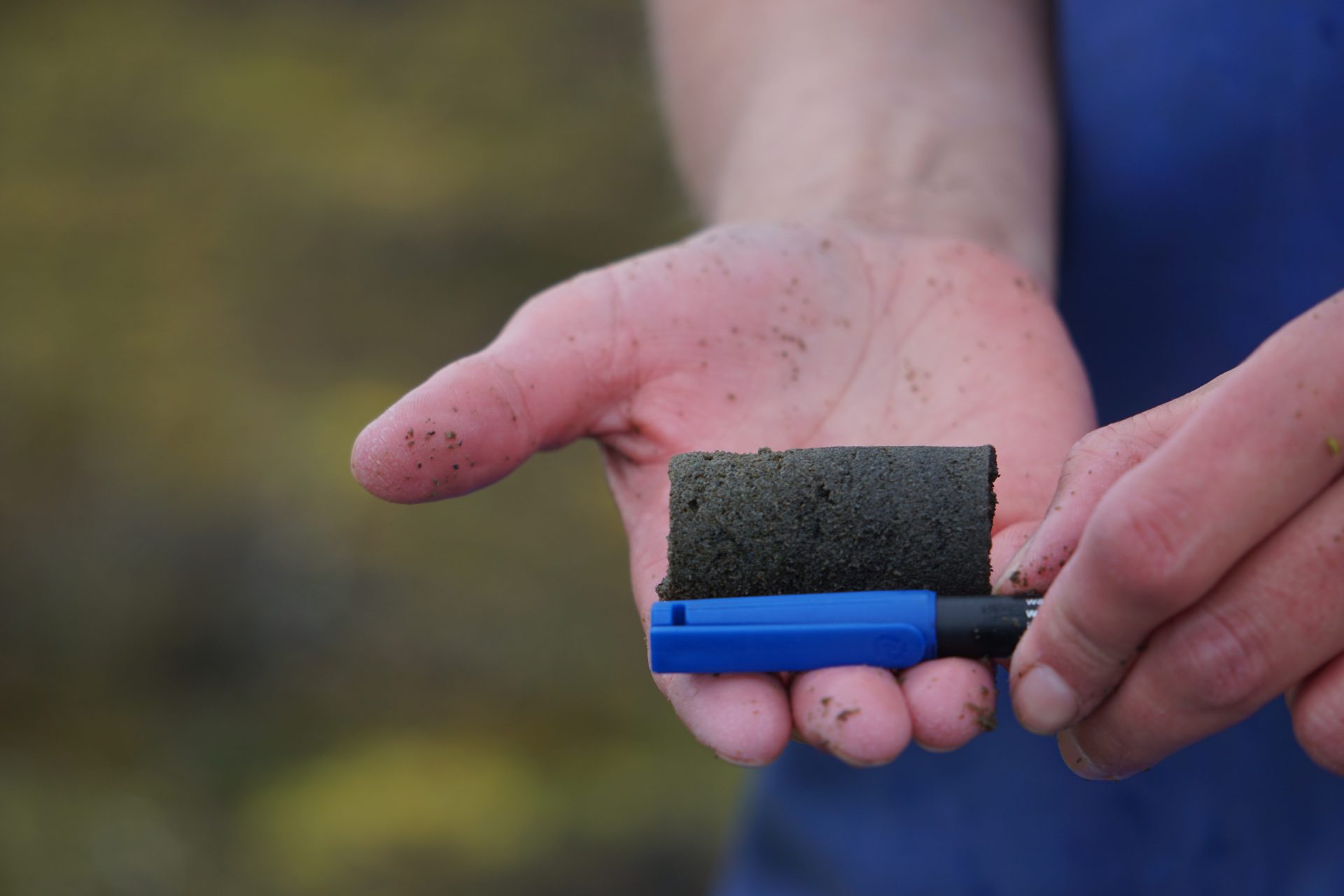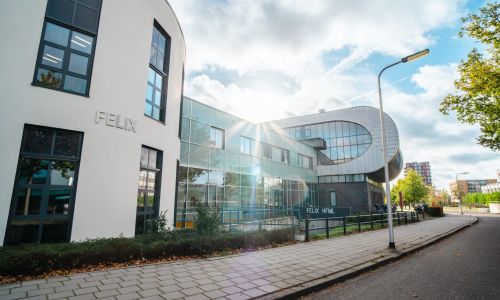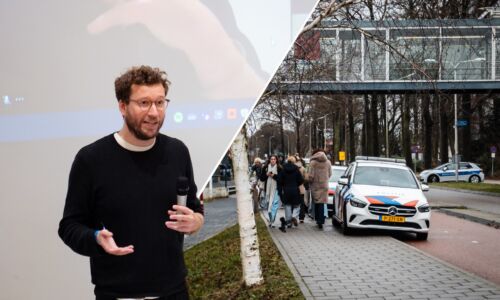Spitsbergen soil samples now in Nijmegen freezer awaiting research
-
 Aquatisch microbiologe Annelies Veraart onderzoekt methaanconcentraties in Spitsbergen. Foto: Rob Buiter
Aquatisch microbiologe Annelies Veraart onderzoekt methaanconcentraties in Spitsbergen. Foto: Rob Buiter
Annelies Veraart was elated when she could finally receive her soil samples from Spitsbergen last week. For the longest time, the tubes of mud were en route from the North Pole to the Netherlands on the cruise ship Ortelius. Now, two months after the climate expedition, Veraart can finally begin her studies of methane concentration in the Spitsbergen soil.
Right now, there are several bits of Spitsbergen’s soil in Annelies Veraart’s home freezer; the tubes of mud and jars of water are stuck between soup and beans. The samples are very valuable, because the odds that the researcher will ever set foot on Spitsbergen again are very slim.
The aquatic microbiologist was part of a climate expedition of fifty scientists to the North Pole in July of this year. She wanted to investigate how much methane could be found in the lakebeds of various freshwater lakes, and if the ecosystem could break down that (harmful) greenhouse gas by itself.

‘We flew back home from Longyearbyen on July 23rd‘, Veraart says, while seated in her office in the Huygens building; her purple ‘Spitsbergen suitcase’ is still in a corner of the room. ‘But the ship carrying our research materials arrived in Yerseke only last week. That might have been the most exciting part of the entire expedition.’
Every scientist could come pick up their research materials by themselves. Veraart drove back very gently with her precious cargo in a cooler, and temporarily stored the samples in her own freezer; she will transfer them to the laboratory as soon as possible, where she can begin the next phase of her work: analysing the mud.
Climate Expedition
The Dutch climate expedition SEES2022 (Scientific Expedition Edgeøya Spitsbergen) had to be postponed by two years because of corona. But last summer, a group of fifty (international) scientists and fifty tourists finally went to the North Pole to research the place with the fastest rising temperatures on earth. Another expedition went to Spitsbergen years earlier, in 2015. Both SEES expeditions were initiatives by ecologist Maarten Loonen, who has been a researcher of geese at the University of Groningen for over 30 years now. Dutch news reporters from the NOS were also on board the cruise ship Ortelius. Their very informative reports can be seen here.
‘I took samples from different depths’, she explains. ‘Those contain different micro-organisms. I want to know how those affect the amount of methane in the soil.’
Polar bears
Veraart showed us pictures of her sticking a PVC pipe into the ground in Spitsbergen, before pulling up damp soil and cutting the resulting ‘sausage’ into slices. ‘I repeated this procedure in seven different lakes. I took roughly twelve samples per lake.’
But that’s easier said than done. The researchers had to use a dinghy to get from the Ortelius to the shore, but the first day was too foggy, and on second day the sea was too choppy. Not only that, o polar bears were also there to spoil the fun. Because of the rising temperatures – Spitsbergen has some of the fastest rising temperatures on the planet – the sea ice melts more quickly in spring, which leaves the bears stuck on the mainland and unable to live on the ice until autumn. Anytime someone spotted a polar bear, the expedition members had to stay on the ship. Once they finally got down to field work, a bear sighting was enough to send them scurrying back to the ship. And to top it all off, there was an outbreak of corona on board.
‘I didn’t disembark from the ship until day five’
‘I didn’t disembark from the ship until day five’, Veraart says. ‘The expedition lasted eleven days. That made it uncertain whether I could do all the research I set out to do.’
She shared a berth on board the Ortelius with a seaweed researcher. There were daily presentations that they could attend. The entire expedition was kind of like a big floating symposium, including a restaurant. So no, she did not have to suffer for her art, Veraart states with a smile. ‘I’ve done field work in Siberia, which was a lot more primitive. We had to ration the food, and barely got any vegetables.’
Warming
It also wasn’t very cold in Spitsbergen. In fact, Veraart refers to the warm temperatures as unheimisch (uncanny, ed.); doing research on the North Pole without wearing a jacket just felt wrong. Not unrelated: her research focuses on the consequences of climate disturbances on methane emissions. ‘When thinking about global warming, people’s minds tend to go right to CO2, but methane is about 80 times stronger than carbon dioxide as a greenhouse gas. But the good news is that methane only remains in the atmosphere for roughly ten years, while CO2 can stay in the atmosphere for hundreds of years. If we want to solve climate change, we have to focus on methane; there’s a lot to be gained there.’
Micro-organisms in wet ecosystems convert organic material to methane. One of Veraart’s research questions is whether lakes that lots of waterfowl excrete in also emit more methane. Additionally, she wants to know what micro-organisms can work as a filter to break methane down again.

Local readings allowed her to draw the conclusion that the amount of methane in the lakes was not worrying. However, at another spot the permafrost had melted, creating a rotting blubber of organic material that was filled with greenhouse gases. ‘And that contributes to faster global warming.’ Insights into these ecological processes can help to think of solutions.
Footprint
There is no previous research into the methane emissions of the lakes of Spitsbergen, so Veraart has no comparative material. It would make sense to check back in a few years to see how high methane concentrations are, but the researcher doubts if that will ever happen.
‘You have to fly there, which is already bad for the environment. And once you leave a footprint in the muddy ground, it will take years for the vegetation to recover from that print. When I was there it felt very much like I was a visitor among the colonies of birds, reindeer, and polar bears; it felt like we humans didn’t belong there. The question is if the knowledge gained at such an expedition can be weighed against the disruption of the environment.’
‘When I was there it felt very much like I was a visitor’
Now the trick becomes to get as much information out of the North Pole samples as possible. For example, Veraart wants to add methane to certain microbial populations to see how quickly they can break down the gas. That will allow her to estimate how resilient the ecosystem is.
In the Netherlands, Veraart contributes to researching the wastewater reclamation using plants. She’s felt an ever-increasing need to prevent more environmental damage to the planet since her visit to Spitsbergen, especially because her and her fellow researchers saw how fast the ice was melting, and what that means for the world. There will be a reunion day in February where the scientists will present their preliminary findings.
The image that will stay with Veraart the longest is that of a polar bear on the shores of Edgeøya. ‘It was the first polar bear I ever saw in the wild, when I was on board the Ortelius. It moved with such grace; it was very impressive.’



